Management and Operations Report: Leadership, Theories, and Operations
VerifiedAdded on 2023/01/18
|13
|4295
|44
Report
AI Summary
This report provides a comprehensive analysis of management and operations, focusing on leadership theories, managerial functions, and their practical application within an organization, specifically ASDA. It explores various management theories, including Management by Objective, Classical management theories, and Behavioral theory, comparing the roles of managers and leaders and outlining their functions such as planning, organizing, directing, and controlling. The report examines different leadership styles, including transformational and transactional leadership, and discusses action-centric leadership and the importance of hard and soft skills. Furthermore, it analyzes how leadership and management apply in situational contexts, such as organizational change and conflict resolution, along with different leadership theories like situational leadership, systems leadership, and task-oriented approaches, evaluating their strengths and weaknesses. The report also explains key approaches to operations management and the roles of leaders and managers in this context, considering environmental factors that impact operational management and decision-making.
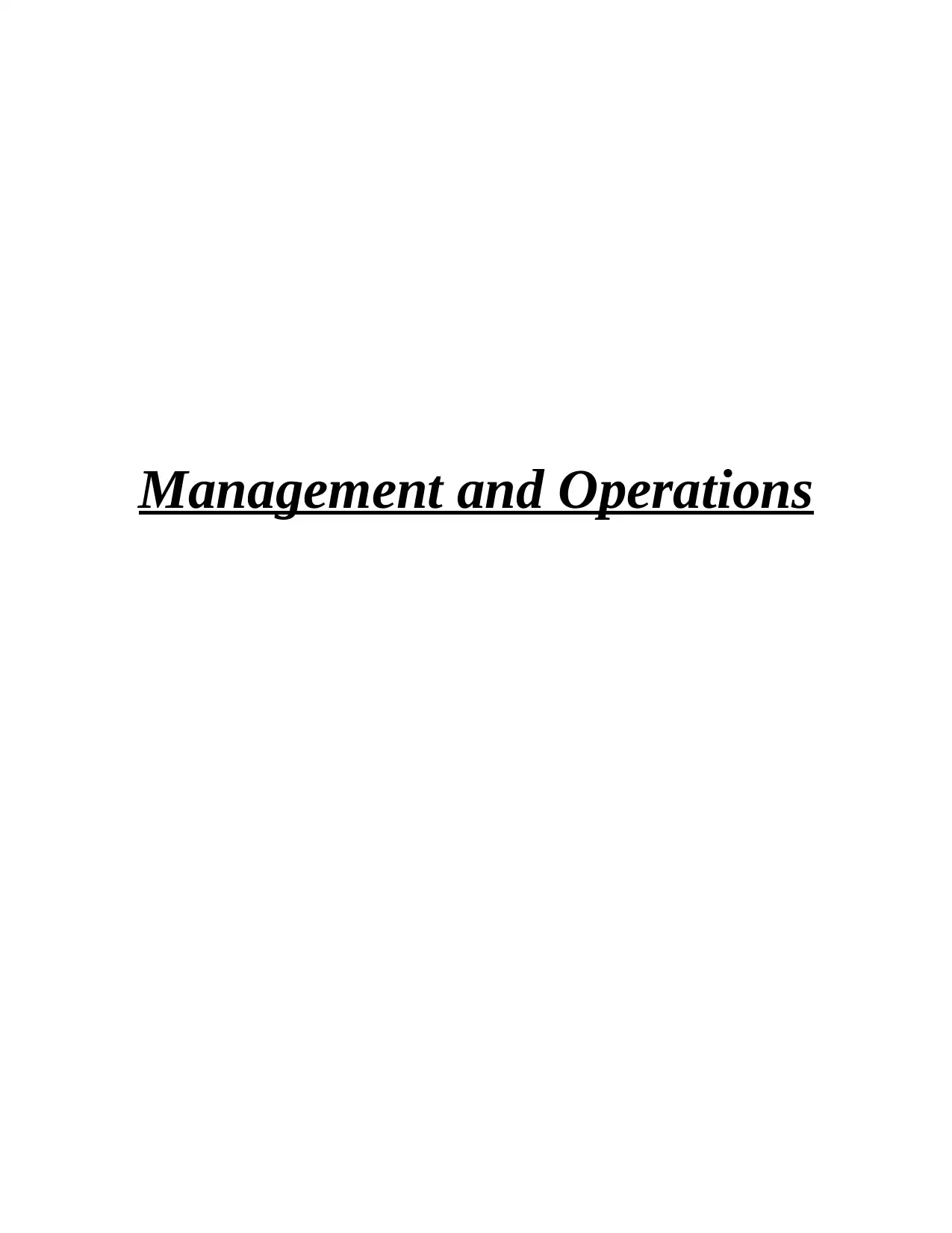
Management and Operations
Paraphrase This Document
Need a fresh take? Get an instant paraphrase of this document with our AI Paraphraser
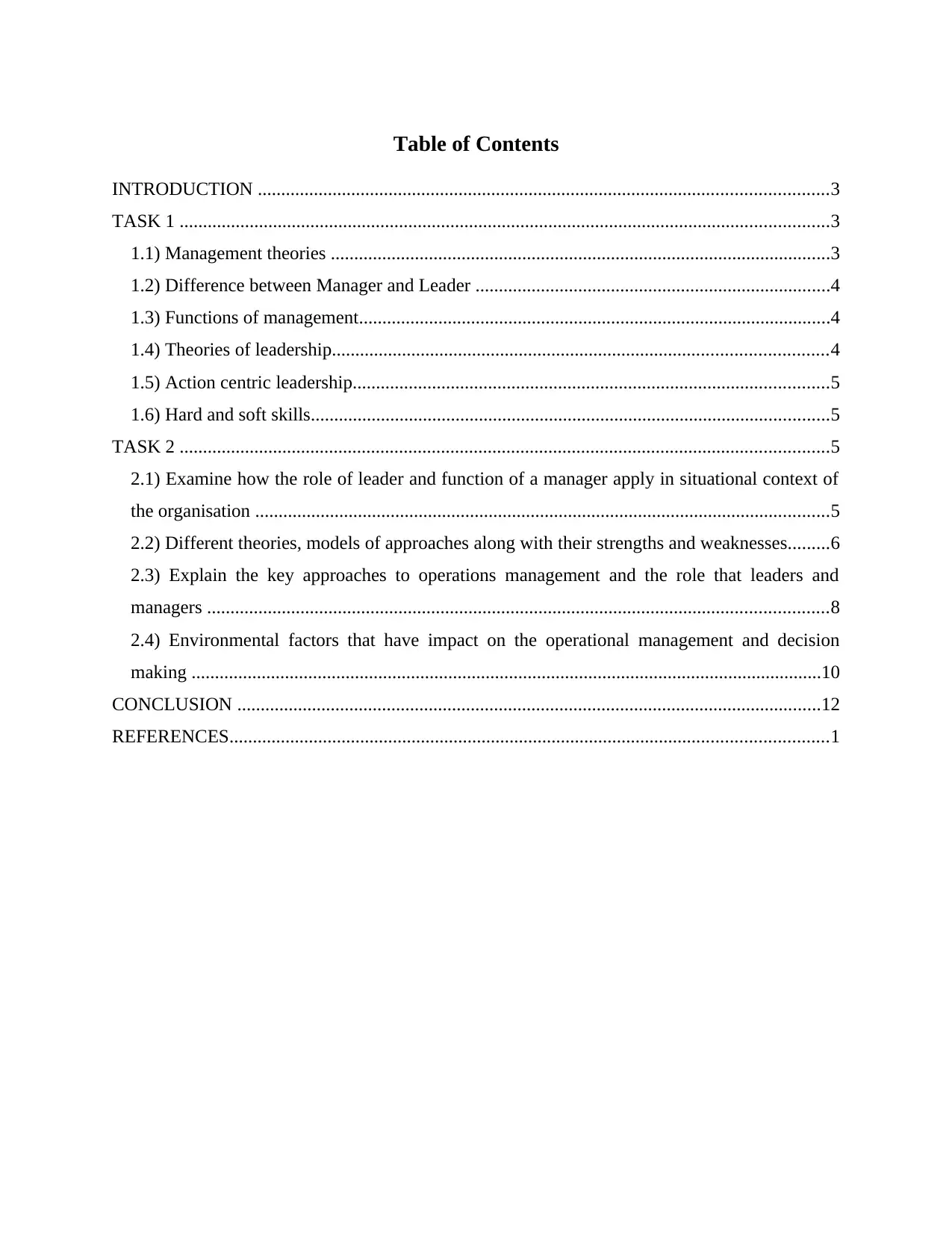
Table of Contents
INTRODUCTION ..........................................................................................................................3
TASK 1 ...........................................................................................................................................3
1.1) Management theories ...........................................................................................................3
1.2) Difference between Manager and Leader ............................................................................4
1.3) Functions of management.....................................................................................................4
1.4) Theories of leadership..........................................................................................................4
1.5) Action centric leadership......................................................................................................5
1.6) Hard and soft skills...............................................................................................................5
TASK 2 ...........................................................................................................................................5
2.1) Examine how the role of leader and function of a manager apply in situational context of
the organisation ...........................................................................................................................5
2.2) Different theories, models of approaches along with their strengths and weaknesses.........6
2.3) Explain the key approaches to operations management and the role that leaders and
managers .....................................................................................................................................8
2.4) Environmental factors that have impact on the operational management and decision
making .......................................................................................................................................10
CONCLUSION .............................................................................................................................12
REFERENCES................................................................................................................................1
INTRODUCTION ..........................................................................................................................3
TASK 1 ...........................................................................................................................................3
1.1) Management theories ...........................................................................................................3
1.2) Difference between Manager and Leader ............................................................................4
1.3) Functions of management.....................................................................................................4
1.4) Theories of leadership..........................................................................................................4
1.5) Action centric leadership......................................................................................................5
1.6) Hard and soft skills...............................................................................................................5
TASK 2 ...........................................................................................................................................5
2.1) Examine how the role of leader and function of a manager apply in situational context of
the organisation ...........................................................................................................................5
2.2) Different theories, models of approaches along with their strengths and weaknesses.........6
2.3) Explain the key approaches to operations management and the role that leaders and
managers .....................................................................................................................................8
2.4) Environmental factors that have impact on the operational management and decision
making .......................................................................................................................................10
CONCLUSION .............................................................................................................................12
REFERENCES................................................................................................................................1
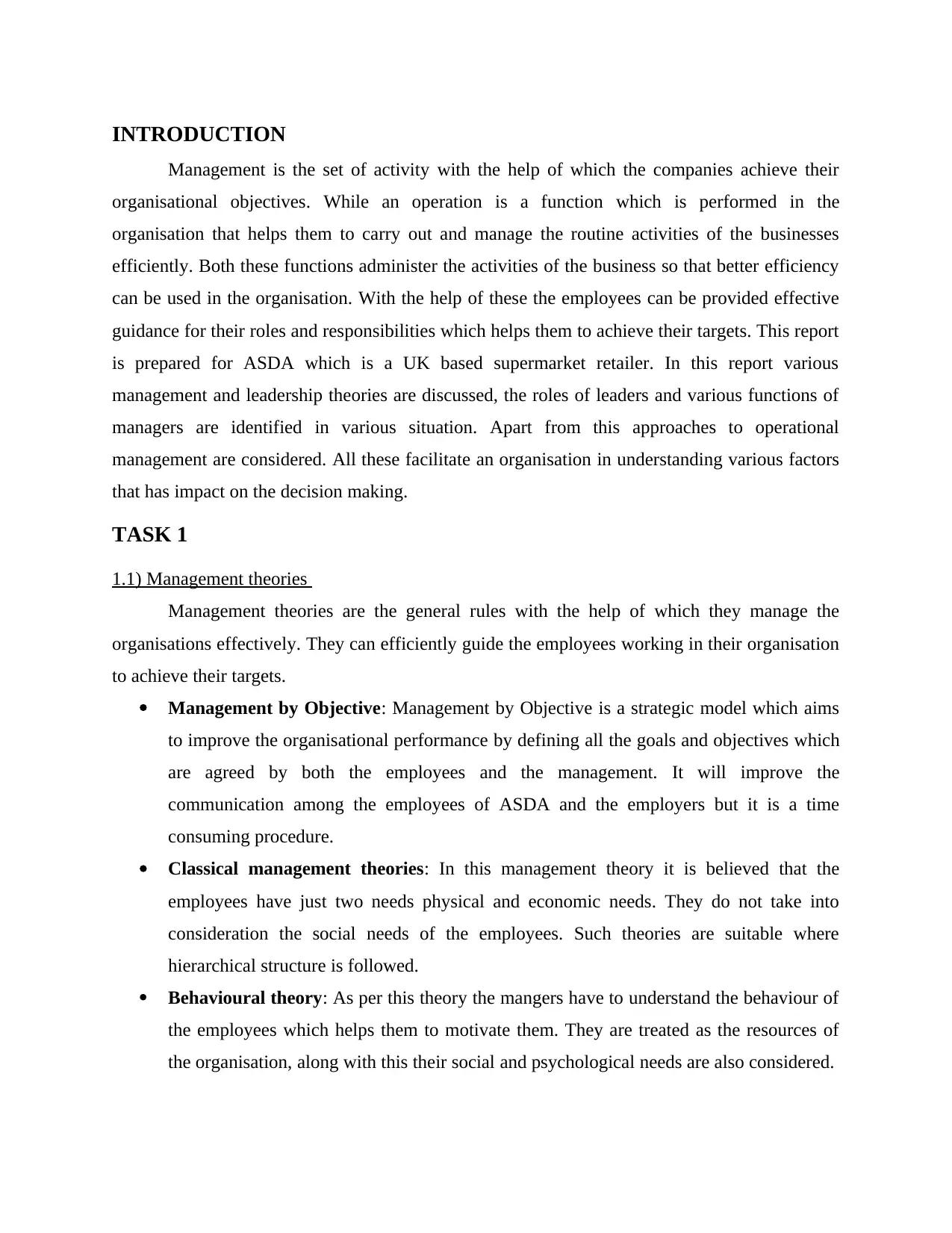
INTRODUCTION
Management is the set of activity with the help of which the companies achieve their
organisational objectives. While an operation is a function which is performed in the
organisation that helps them to carry out and manage the routine activities of the businesses
efficiently. Both these functions administer the activities of the business so that better efficiency
can be used in the organisation. With the help of these the employees can be provided effective
guidance for their roles and responsibilities which helps them to achieve their targets. This report
is prepared for ASDA which is a UK based supermarket retailer. In this report various
management and leadership theories are discussed, the roles of leaders and various functions of
managers are identified in various situation. Apart from this approaches to operational
management are considered. All these facilitate an organisation in understanding various factors
that has impact on the decision making.
TASK 1
1.1) Management theories
Management theories are the general rules with the help of which they manage the
organisations effectively. They can efficiently guide the employees working in their organisation
to achieve their targets.
Management by Objective: Management by Objective is a strategic model which aims
to improve the organisational performance by defining all the goals and objectives which
are agreed by both the employees and the management. It will improve the
communication among the employees of ASDA and the employers but it is a time
consuming procedure.
Classical management theories: In this management theory it is believed that the
employees have just two needs physical and economic needs. They do not take into
consideration the social needs of the employees. Such theories are suitable where
hierarchical structure is followed.
Behavioural theory: As per this theory the mangers have to understand the behaviour of
the employees which helps them to motivate them. They are treated as the resources of
the organisation, along with this their social and psychological needs are also considered.
Management is the set of activity with the help of which the companies achieve their
organisational objectives. While an operation is a function which is performed in the
organisation that helps them to carry out and manage the routine activities of the businesses
efficiently. Both these functions administer the activities of the business so that better efficiency
can be used in the organisation. With the help of these the employees can be provided effective
guidance for their roles and responsibilities which helps them to achieve their targets. This report
is prepared for ASDA which is a UK based supermarket retailer. In this report various
management and leadership theories are discussed, the roles of leaders and various functions of
managers are identified in various situation. Apart from this approaches to operational
management are considered. All these facilitate an organisation in understanding various factors
that has impact on the decision making.
TASK 1
1.1) Management theories
Management theories are the general rules with the help of which they manage the
organisations effectively. They can efficiently guide the employees working in their organisation
to achieve their targets.
Management by Objective: Management by Objective is a strategic model which aims
to improve the organisational performance by defining all the goals and objectives which
are agreed by both the employees and the management. It will improve the
communication among the employees of ASDA and the employers but it is a time
consuming procedure.
Classical management theories: In this management theory it is believed that the
employees have just two needs physical and economic needs. They do not take into
consideration the social needs of the employees. Such theories are suitable where
hierarchical structure is followed.
Behavioural theory: As per this theory the mangers have to understand the behaviour of
the employees which helps them to motivate them. They are treated as the resources of
the organisation, along with this their social and psychological needs are also considered.
⊘ This is a preview!⊘
Do you want full access?
Subscribe today to unlock all pages.

Trusted by 1+ million students worldwide
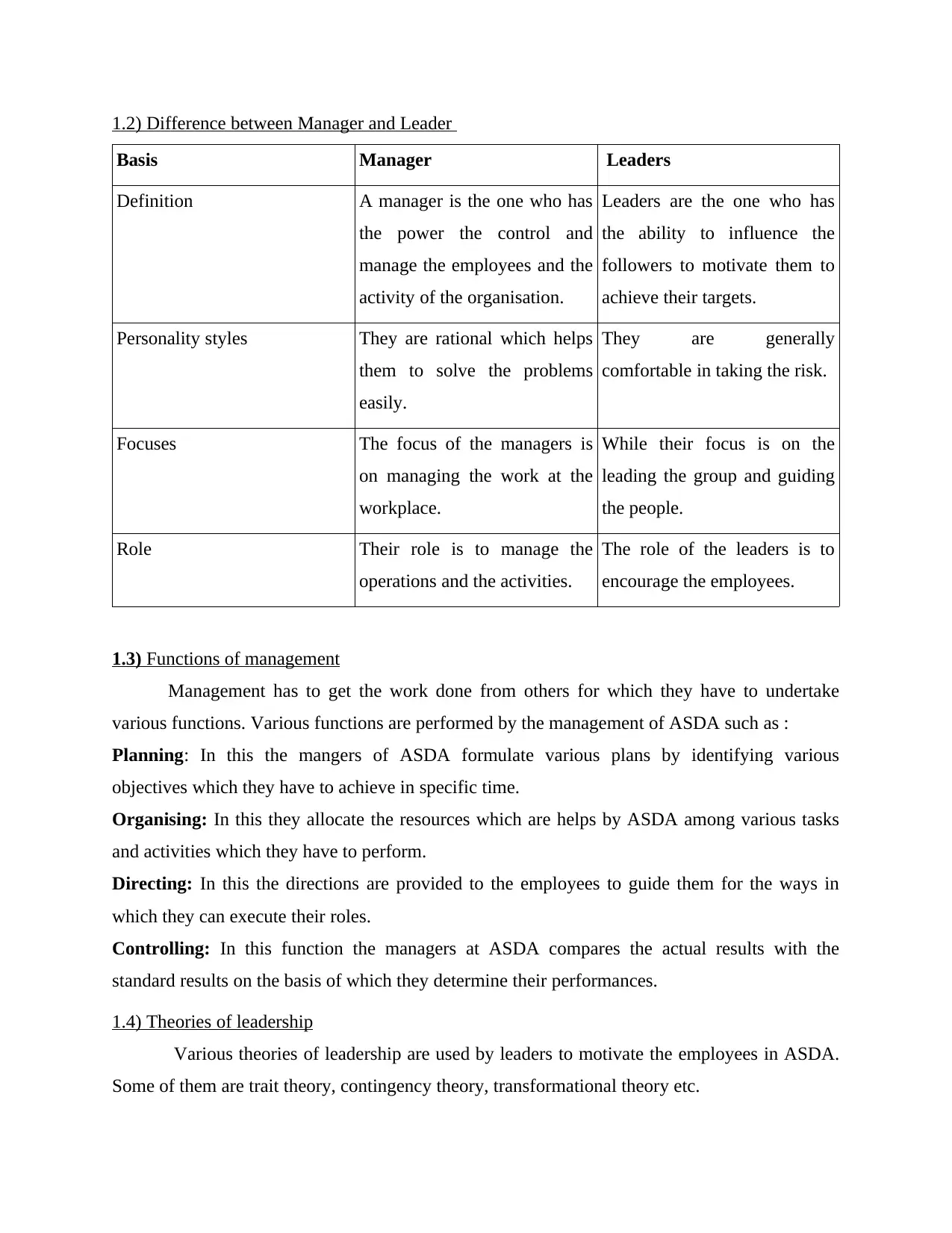
1.2) Difference between Manager and Leader
Basis Manager Leaders
Definition A manager is the one who has
the power the control and
manage the employees and the
activity of the organisation.
Leaders are the one who has
the ability to influence the
followers to motivate them to
achieve their targets.
Personality styles They are rational which helps
them to solve the problems
easily.
They are generally
comfortable in taking the risk.
Focuses The focus of the managers is
on managing the work at the
workplace.
While their focus is on the
leading the group and guiding
the people.
Role Their role is to manage the
operations and the activities.
The role of the leaders is to
encourage the employees.
1.3) Functions of management
Management has to get the work done from others for which they have to undertake
various functions. Various functions are performed by the management of ASDA such as :
Planning: In this the mangers of ASDA formulate various plans by identifying various
objectives which they have to achieve in specific time.
Organising: In this they allocate the resources which are helps by ASDA among various tasks
and activities which they have to perform.
Directing: In this the directions are provided to the employees to guide them for the ways in
which they can execute their roles.
Controlling: In this function the managers at ASDA compares the actual results with the
standard results on the basis of which they determine their performances.
1.4) Theories of leadership
Various theories of leadership are used by leaders to motivate the employees in ASDA.
Some of them are trait theory, contingency theory, transformational theory etc.
Basis Manager Leaders
Definition A manager is the one who has
the power the control and
manage the employees and the
activity of the organisation.
Leaders are the one who has
the ability to influence the
followers to motivate them to
achieve their targets.
Personality styles They are rational which helps
them to solve the problems
easily.
They are generally
comfortable in taking the risk.
Focuses The focus of the managers is
on managing the work at the
workplace.
While their focus is on the
leading the group and guiding
the people.
Role Their role is to manage the
operations and the activities.
The role of the leaders is to
encourage the employees.
1.3) Functions of management
Management has to get the work done from others for which they have to undertake
various functions. Various functions are performed by the management of ASDA such as :
Planning: In this the mangers of ASDA formulate various plans by identifying various
objectives which they have to achieve in specific time.
Organising: In this they allocate the resources which are helps by ASDA among various tasks
and activities which they have to perform.
Directing: In this the directions are provided to the employees to guide them for the ways in
which they can execute their roles.
Controlling: In this function the managers at ASDA compares the actual results with the
standard results on the basis of which they determine their performances.
1.4) Theories of leadership
Various theories of leadership are used by leaders to motivate the employees in ASDA.
Some of them are trait theory, contingency theory, transformational theory etc.
Paraphrase This Document
Need a fresh take? Get an instant paraphrase of this document with our AI Paraphraser
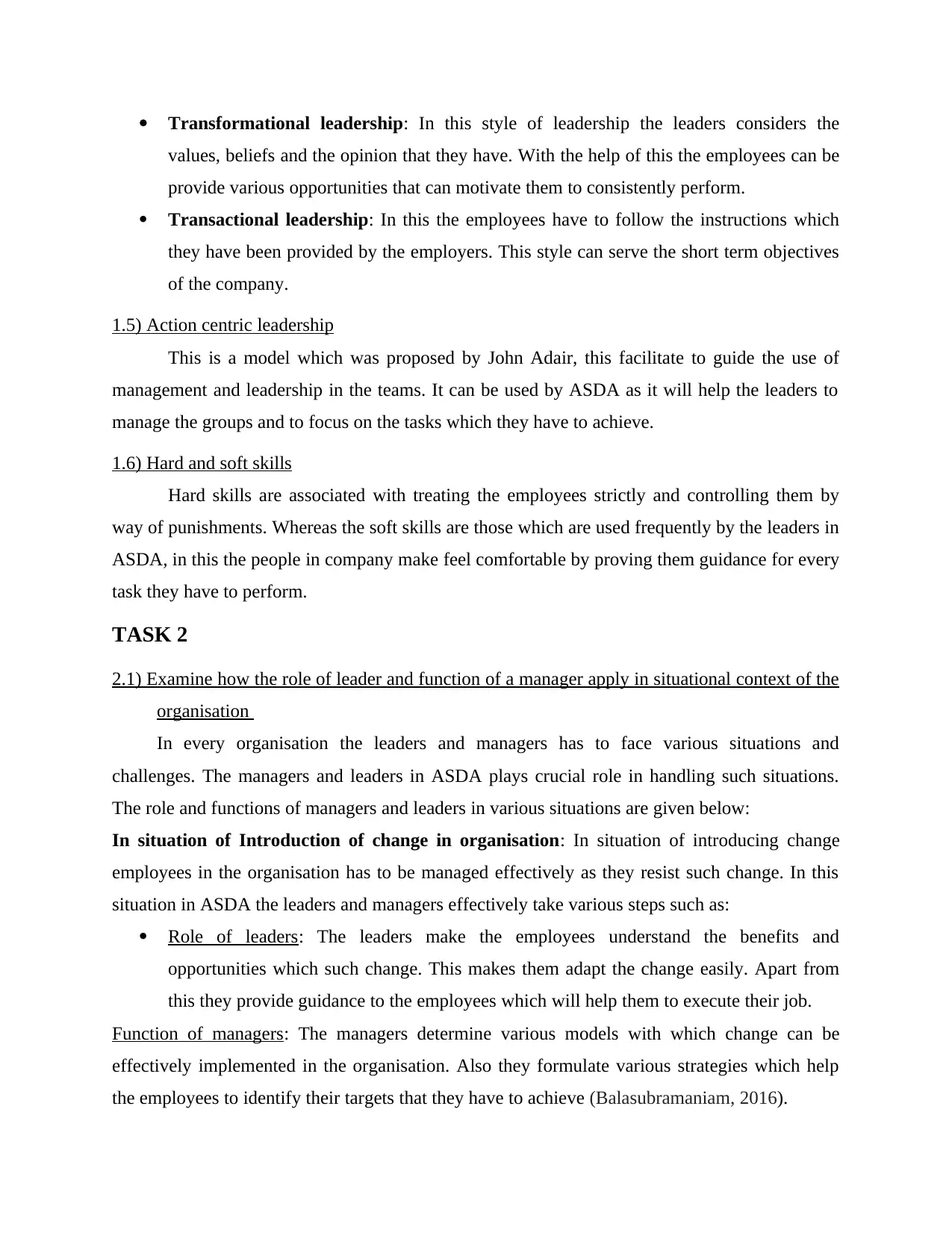
Transformational leadership: In this style of leadership the leaders considers the
values, beliefs and the opinion that they have. With the help of this the employees can be
provide various opportunities that can motivate them to consistently perform.
Transactional leadership: In this the employees have to follow the instructions which
they have been provided by the employers. This style can serve the short term objectives
of the company.
1.5) Action centric leadership
This is a model which was proposed by John Adair, this facilitate to guide the use of
management and leadership in the teams. It can be used by ASDA as it will help the leaders to
manage the groups and to focus on the tasks which they have to achieve.
1.6) Hard and soft skills
Hard skills are associated with treating the employees strictly and controlling them by
way of punishments. Whereas the soft skills are those which are used frequently by the leaders in
ASDA, in this the people in company make feel comfortable by proving them guidance for every
task they have to perform.
TASK 2
2.1) Examine how the role of leader and function of a manager apply in situational context of the
organisation
In every organisation the leaders and managers has to face various situations and
challenges. The managers and leaders in ASDA plays crucial role in handling such situations.
The role and functions of managers and leaders in various situations are given below:
In situation of Introduction of change in organisation: In situation of introducing change
employees in the organisation has to be managed effectively as they resist such change. In this
situation in ASDA the leaders and managers effectively take various steps such as:
Role of leaders: The leaders make the employees understand the benefits and
opportunities which such change. This makes them adapt the change easily. Apart from
this they provide guidance to the employees which will help them to execute their job.
Function of managers: The managers determine various models with which change can be
effectively implemented in the organisation. Also they formulate various strategies which help
the employees to identify their targets that they have to achieve (Balasubramaniam, 2016).
values, beliefs and the opinion that they have. With the help of this the employees can be
provide various opportunities that can motivate them to consistently perform.
Transactional leadership: In this the employees have to follow the instructions which
they have been provided by the employers. This style can serve the short term objectives
of the company.
1.5) Action centric leadership
This is a model which was proposed by John Adair, this facilitate to guide the use of
management and leadership in the teams. It can be used by ASDA as it will help the leaders to
manage the groups and to focus on the tasks which they have to achieve.
1.6) Hard and soft skills
Hard skills are associated with treating the employees strictly and controlling them by
way of punishments. Whereas the soft skills are those which are used frequently by the leaders in
ASDA, in this the people in company make feel comfortable by proving them guidance for every
task they have to perform.
TASK 2
2.1) Examine how the role of leader and function of a manager apply in situational context of the
organisation
In every organisation the leaders and managers has to face various situations and
challenges. The managers and leaders in ASDA plays crucial role in handling such situations.
The role and functions of managers and leaders in various situations are given below:
In situation of Introduction of change in organisation: In situation of introducing change
employees in the organisation has to be managed effectively as they resist such change. In this
situation in ASDA the leaders and managers effectively take various steps such as:
Role of leaders: The leaders make the employees understand the benefits and
opportunities which such change. This makes them adapt the change easily. Apart from
this they provide guidance to the employees which will help them to execute their job.
Function of managers: The managers determine various models with which change can be
effectively implemented in the organisation. Also they formulate various strategies which help
the employees to identify their targets that they have to achieve (Balasubramaniam, 2016).
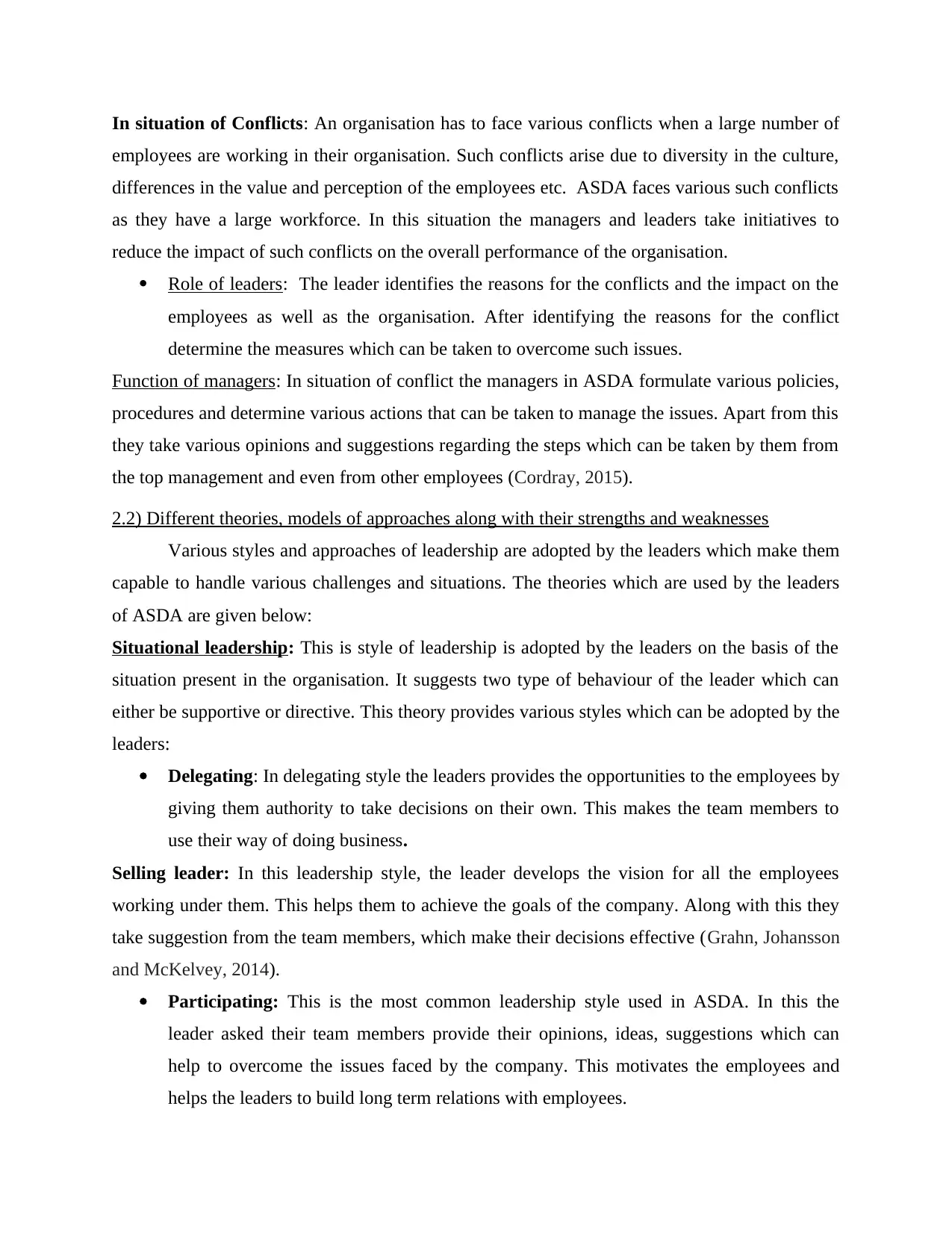
In situation of Conflicts: An organisation has to face various conflicts when a large number of
employees are working in their organisation. Such conflicts arise due to diversity in the culture,
differences in the value and perception of the employees etc. ASDA faces various such conflicts
as they have a large workforce. In this situation the managers and leaders take initiatives to
reduce the impact of such conflicts on the overall performance of the organisation.
Role of leaders: The leader identifies the reasons for the conflicts and the impact on the
employees as well as the organisation. After identifying the reasons for the conflict
determine the measures which can be taken to overcome such issues.
Function of managers: In situation of conflict the managers in ASDA formulate various policies,
procedures and determine various actions that can be taken to manage the issues. Apart from this
they take various opinions and suggestions regarding the steps which can be taken by them from
the top management and even from other employees (Cordray, 2015).
2.2) Different theories, models of approaches along with their strengths and weaknesses
Various styles and approaches of leadership are adopted by the leaders which make them
capable to handle various challenges and situations. The theories which are used by the leaders
of ASDA are given below:
Situational leadership: This is style of leadership is adopted by the leaders on the basis of the
situation present in the organisation. It suggests two type of behaviour of the leader which can
either be supportive or directive. This theory provides various styles which can be adopted by the
leaders:
Delegating: In delegating style the leaders provides the opportunities to the employees by
giving them authority to take decisions on their own. This makes the team members to
use their way of doing business.
Selling leader: In this leadership style, the leader develops the vision for all the employees
working under them. This helps them to achieve the goals of the company. Along with this they
take suggestion from the team members, which make their decisions effective (Grahn, Johansson
and McKelvey, 2014).
Participating: This is the most common leadership style used in ASDA. In this the
leader asked their team members provide their opinions, ideas, suggestions which can
help to overcome the issues faced by the company. This motivates the employees and
helps the leaders to build long term relations with employees.
employees are working in their organisation. Such conflicts arise due to diversity in the culture,
differences in the value and perception of the employees etc. ASDA faces various such conflicts
as they have a large workforce. In this situation the managers and leaders take initiatives to
reduce the impact of such conflicts on the overall performance of the organisation.
Role of leaders: The leader identifies the reasons for the conflicts and the impact on the
employees as well as the organisation. After identifying the reasons for the conflict
determine the measures which can be taken to overcome such issues.
Function of managers: In situation of conflict the managers in ASDA formulate various policies,
procedures and determine various actions that can be taken to manage the issues. Apart from this
they take various opinions and suggestions regarding the steps which can be taken by them from
the top management and even from other employees (Cordray, 2015).
2.2) Different theories, models of approaches along with their strengths and weaknesses
Various styles and approaches of leadership are adopted by the leaders which make them
capable to handle various challenges and situations. The theories which are used by the leaders
of ASDA are given below:
Situational leadership: This is style of leadership is adopted by the leaders on the basis of the
situation present in the organisation. It suggests two type of behaviour of the leader which can
either be supportive or directive. This theory provides various styles which can be adopted by the
leaders:
Delegating: In delegating style the leaders provides the opportunities to the employees by
giving them authority to take decisions on their own. This makes the team members to
use their way of doing business.
Selling leader: In this leadership style, the leader develops the vision for all the employees
working under them. This helps them to achieve the goals of the company. Along with this they
take suggestion from the team members, which make their decisions effective (Grahn, Johansson
and McKelvey, 2014).
Participating: This is the most common leadership style used in ASDA. In this the
leader asked their team members provide their opinions, ideas, suggestions which can
help to overcome the issues faced by the company. This motivates the employees and
helps the leaders to build long term relations with employees.
⊘ This is a preview!⊘
Do you want full access?
Subscribe today to unlock all pages.

Trusted by 1+ million students worldwide
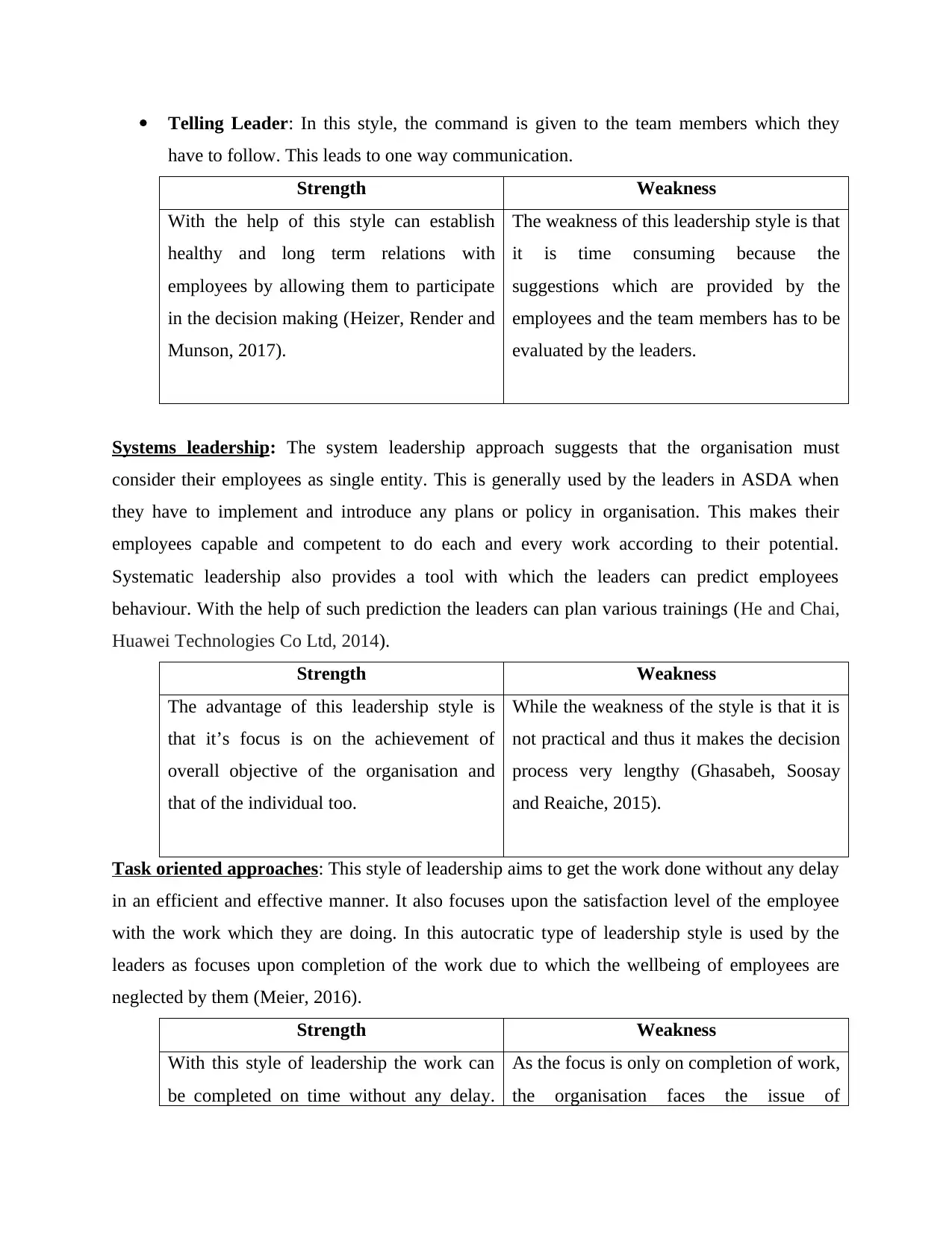
Telling Leader: In this style, the command is given to the team members which they
have to follow. This leads to one way communication.
Strength Weakness
With the help of this style can establish
healthy and long term relations with
employees by allowing them to participate
in the decision making (Heizer, Render and
Munson, 2017).
The weakness of this leadership style is that
it is time consuming because the
suggestions which are provided by the
employees and the team members has to be
evaluated by the leaders.
Systems leadership: The system leadership approach suggests that the organisation must
consider their employees as single entity. This is generally used by the leaders in ASDA when
they have to implement and introduce any plans or policy in organisation. This makes their
employees capable and competent to do each and every work according to their potential.
Systematic leadership also provides a tool with which the leaders can predict employees
behaviour. With the help of such prediction the leaders can plan various trainings (He and Chai,
Huawei Technologies Co Ltd, 2014).
Strength Weakness
The advantage of this leadership style is
that it’s focus is on the achievement of
overall objective of the organisation and
that of the individual too.
While the weakness of the style is that it is
not practical and thus it makes the decision
process very lengthy (Ghasabeh, Soosay
and Reaiche, 2015).
Task oriented approaches: This style of leadership aims to get the work done without any delay
in an efficient and effective manner. It also focuses upon the satisfaction level of the employee
with the work which they are doing. In this autocratic type of leadership style is used by the
leaders as focuses upon completion of the work due to which the wellbeing of employees are
neglected by them (Meier, 2016).
Strength Weakness
With this style of leadership the work can
be completed on time without any delay.
As the focus is only on completion of work,
the organisation faces the issue of
have to follow. This leads to one way communication.
Strength Weakness
With the help of this style can establish
healthy and long term relations with
employees by allowing them to participate
in the decision making (Heizer, Render and
Munson, 2017).
The weakness of this leadership style is that
it is time consuming because the
suggestions which are provided by the
employees and the team members has to be
evaluated by the leaders.
Systems leadership: The system leadership approach suggests that the organisation must
consider their employees as single entity. This is generally used by the leaders in ASDA when
they have to implement and introduce any plans or policy in organisation. This makes their
employees capable and competent to do each and every work according to their potential.
Systematic leadership also provides a tool with which the leaders can predict employees
behaviour. With the help of such prediction the leaders can plan various trainings (He and Chai,
Huawei Technologies Co Ltd, 2014).
Strength Weakness
The advantage of this leadership style is
that it’s focus is on the achievement of
overall objective of the organisation and
that of the individual too.
While the weakness of the style is that it is
not practical and thus it makes the decision
process very lengthy (Ghasabeh, Soosay
and Reaiche, 2015).
Task oriented approaches: This style of leadership aims to get the work done without any delay
in an efficient and effective manner. It also focuses upon the satisfaction level of the employee
with the work which they are doing. In this autocratic type of leadership style is used by the
leaders as focuses upon completion of the work due to which the wellbeing of employees are
neglected by them (Meier, 2016).
Strength Weakness
With this style of leadership the work can
be completed on time without any delay.
As the focus is only on completion of work,
the organisation faces the issue of
Paraphrase This Document
Need a fresh take? Get an instant paraphrase of this document with our AI Paraphraser
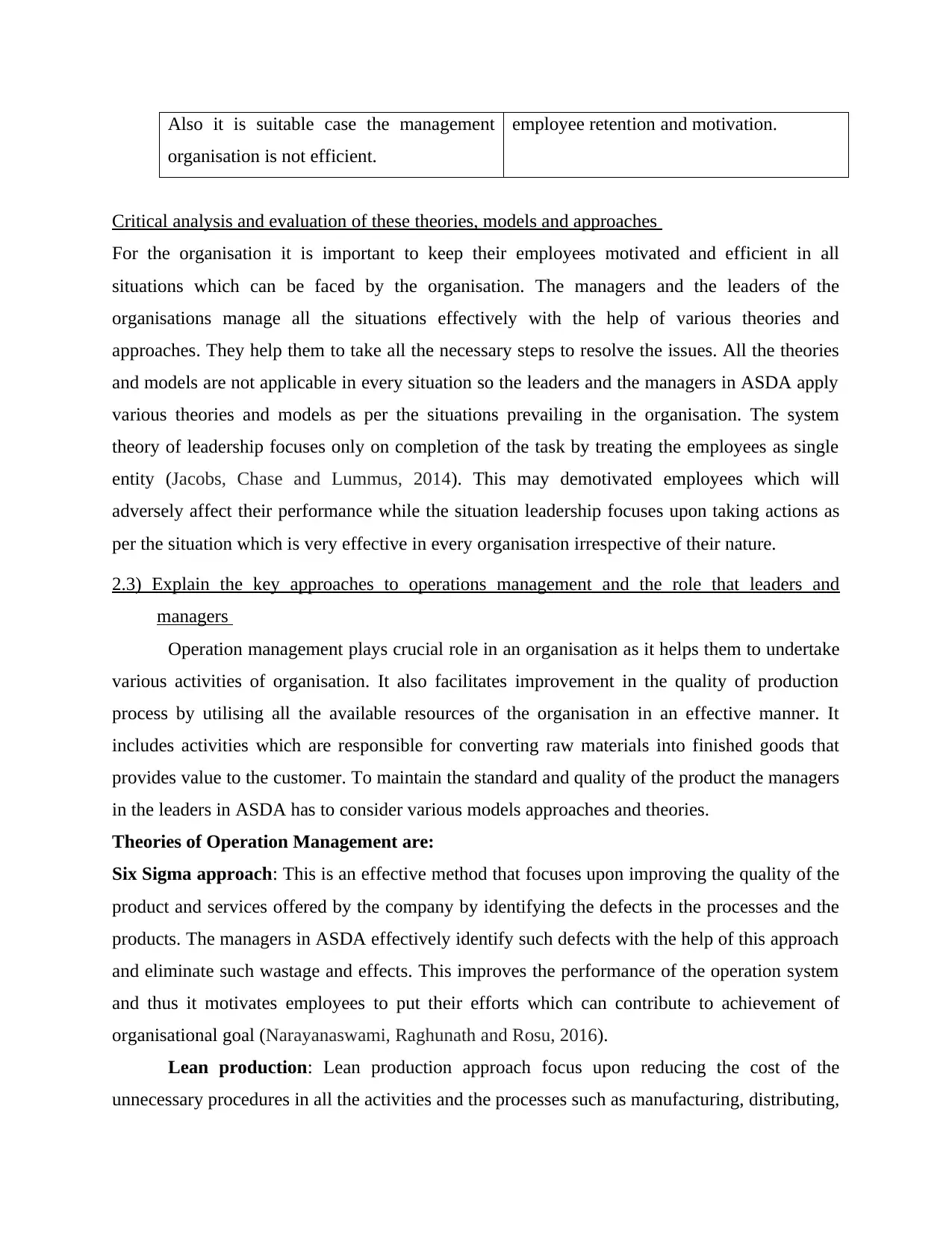
Also it is suitable case the management
organisation is not efficient.
employee retention and motivation.
Critical analysis and evaluation of these theories, models and approaches
For the organisation it is important to keep their employees motivated and efficient in all
situations which can be faced by the organisation. The managers and the leaders of the
organisations manage all the situations effectively with the help of various theories and
approaches. They help them to take all the necessary steps to resolve the issues. All the theories
and models are not applicable in every situation so the leaders and the managers in ASDA apply
various theories and models as per the situations prevailing in the organisation. The system
theory of leadership focuses only on completion of the task by treating the employees as single
entity (Jacobs, Chase and Lummus, 2014). This may demotivated employees which will
adversely affect their performance while the situation leadership focuses upon taking actions as
per the situation which is very effective in every organisation irrespective of their nature.
2.3) Explain the key approaches to operations management and the role that leaders and
managers
Operation management plays crucial role in an organisation as it helps them to undertake
various activities of organisation. It also facilitates improvement in the quality of production
process by utilising all the available resources of the organisation in an effective manner. It
includes activities which are responsible for converting raw materials into finished goods that
provides value to the customer. To maintain the standard and quality of the product the managers
in the leaders in ASDA has to consider various models approaches and theories.
Theories of Operation Management are:
Six Sigma approach: This is an effective method that focuses upon improving the quality of the
product and services offered by the company by identifying the defects in the processes and the
products. The managers in ASDA effectively identify such defects with the help of this approach
and eliminate such wastage and effects. This improves the performance of the operation system
and thus it motivates employees to put their efforts which can contribute to achievement of
organisational goal (Narayanaswami, Raghunath and Rosu, 2016).
Lean production: Lean production approach focus upon reducing the cost of the
unnecessary procedures in all the activities and the processes such as manufacturing, distributing,
organisation is not efficient.
employee retention and motivation.
Critical analysis and evaluation of these theories, models and approaches
For the organisation it is important to keep their employees motivated and efficient in all
situations which can be faced by the organisation. The managers and the leaders of the
organisations manage all the situations effectively with the help of various theories and
approaches. They help them to take all the necessary steps to resolve the issues. All the theories
and models are not applicable in every situation so the leaders and the managers in ASDA apply
various theories and models as per the situations prevailing in the organisation. The system
theory of leadership focuses only on completion of the task by treating the employees as single
entity (Jacobs, Chase and Lummus, 2014). This may demotivated employees which will
adversely affect their performance while the situation leadership focuses upon taking actions as
per the situation which is very effective in every organisation irrespective of their nature.
2.3) Explain the key approaches to operations management and the role that leaders and
managers
Operation management plays crucial role in an organisation as it helps them to undertake
various activities of organisation. It also facilitates improvement in the quality of production
process by utilising all the available resources of the organisation in an effective manner. It
includes activities which are responsible for converting raw materials into finished goods that
provides value to the customer. To maintain the standard and quality of the product the managers
in the leaders in ASDA has to consider various models approaches and theories.
Theories of Operation Management are:
Six Sigma approach: This is an effective method that focuses upon improving the quality of the
product and services offered by the company by identifying the defects in the processes and the
products. The managers in ASDA effectively identify such defects with the help of this approach
and eliminate such wastage and effects. This improves the performance of the operation system
and thus it motivates employees to put their efforts which can contribute to achievement of
organisational goal (Narayanaswami, Raghunath and Rosu, 2016).
Lean production: Lean production approach focus upon reducing the cost of the
unnecessary procedures in all the activities and the processes such as manufacturing, distributing,
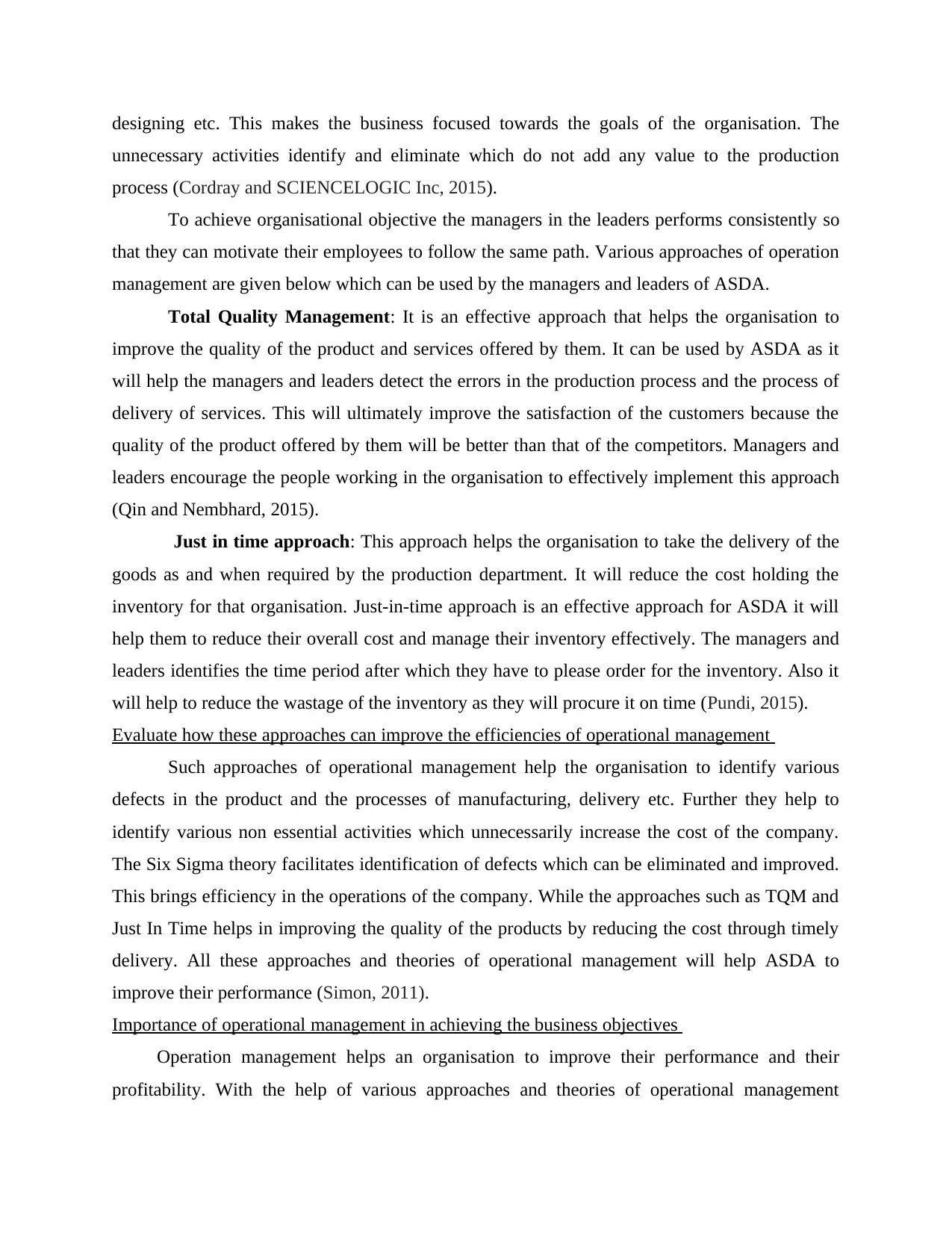
designing etc. This makes the business focused towards the goals of the organisation. The
unnecessary activities identify and eliminate which do not add any value to the production
process (Cordray and SCIENCELOGIC Inc, 2015).
To achieve organisational objective the managers in the leaders performs consistently so
that they can motivate their employees to follow the same path. Various approaches of operation
management are given below which can be used by the managers and leaders of ASDA.
Total Quality Management: It is an effective approach that helps the organisation to
improve the quality of the product and services offered by them. It can be used by ASDA as it
will help the managers and leaders detect the errors in the production process and the process of
delivery of services. This will ultimately improve the satisfaction of the customers because the
quality of the product offered by them will be better than that of the competitors. Managers and
leaders encourage the people working in the organisation to effectively implement this approach
(Qin and Nembhard, 2015).
Just in time approach: This approach helps the organisation to take the delivery of the
goods as and when required by the production department. It will reduce the cost holding the
inventory for that organisation. Just-in-time approach is an effective approach for ASDA it will
help them to reduce their overall cost and manage their inventory effectively. The managers and
leaders identifies the time period after which they have to please order for the inventory. Also it
will help to reduce the wastage of the inventory as they will procure it on time (Pundi, 2015).
Evaluate how these approaches can improve the efficiencies of operational management
Such approaches of operational management help the organisation to identify various
defects in the product and the processes of manufacturing, delivery etc. Further they help to
identify various non essential activities which unnecessarily increase the cost of the company.
The Six Sigma theory facilitates identification of defects which can be eliminated and improved.
This brings efficiency in the operations of the company. While the approaches such as TQM and
Just In Time helps in improving the quality of the products by reducing the cost through timely
delivery. All these approaches and theories of operational management will help ASDA to
improve their performance (Simon, 2011).
Importance of operational management in achieving the business objectives
Operation management helps an organisation to improve their performance and their
profitability. With the help of various approaches and theories of operational management
unnecessary activities identify and eliminate which do not add any value to the production
process (Cordray and SCIENCELOGIC Inc, 2015).
To achieve organisational objective the managers in the leaders performs consistently so
that they can motivate their employees to follow the same path. Various approaches of operation
management are given below which can be used by the managers and leaders of ASDA.
Total Quality Management: It is an effective approach that helps the organisation to
improve the quality of the product and services offered by them. It can be used by ASDA as it
will help the managers and leaders detect the errors in the production process and the process of
delivery of services. This will ultimately improve the satisfaction of the customers because the
quality of the product offered by them will be better than that of the competitors. Managers and
leaders encourage the people working in the organisation to effectively implement this approach
(Qin and Nembhard, 2015).
Just in time approach: This approach helps the organisation to take the delivery of the
goods as and when required by the production department. It will reduce the cost holding the
inventory for that organisation. Just-in-time approach is an effective approach for ASDA it will
help them to reduce their overall cost and manage their inventory effectively. The managers and
leaders identifies the time period after which they have to please order for the inventory. Also it
will help to reduce the wastage of the inventory as they will procure it on time (Pundi, 2015).
Evaluate how these approaches can improve the efficiencies of operational management
Such approaches of operational management help the organisation to identify various
defects in the product and the processes of manufacturing, delivery etc. Further they help to
identify various non essential activities which unnecessarily increase the cost of the company.
The Six Sigma theory facilitates identification of defects which can be eliminated and improved.
This brings efficiency in the operations of the company. While the approaches such as TQM and
Just In Time helps in improving the quality of the products by reducing the cost through timely
delivery. All these approaches and theories of operational management will help ASDA to
improve their performance (Simon, 2011).
Importance of operational management in achieving the business objectives
Operation management helps an organisation to improve their performance and their
profitability. With the help of various approaches and theories of operational management
⊘ This is a preview!⊘
Do you want full access?
Subscribe today to unlock all pages.

Trusted by 1+ million students worldwide
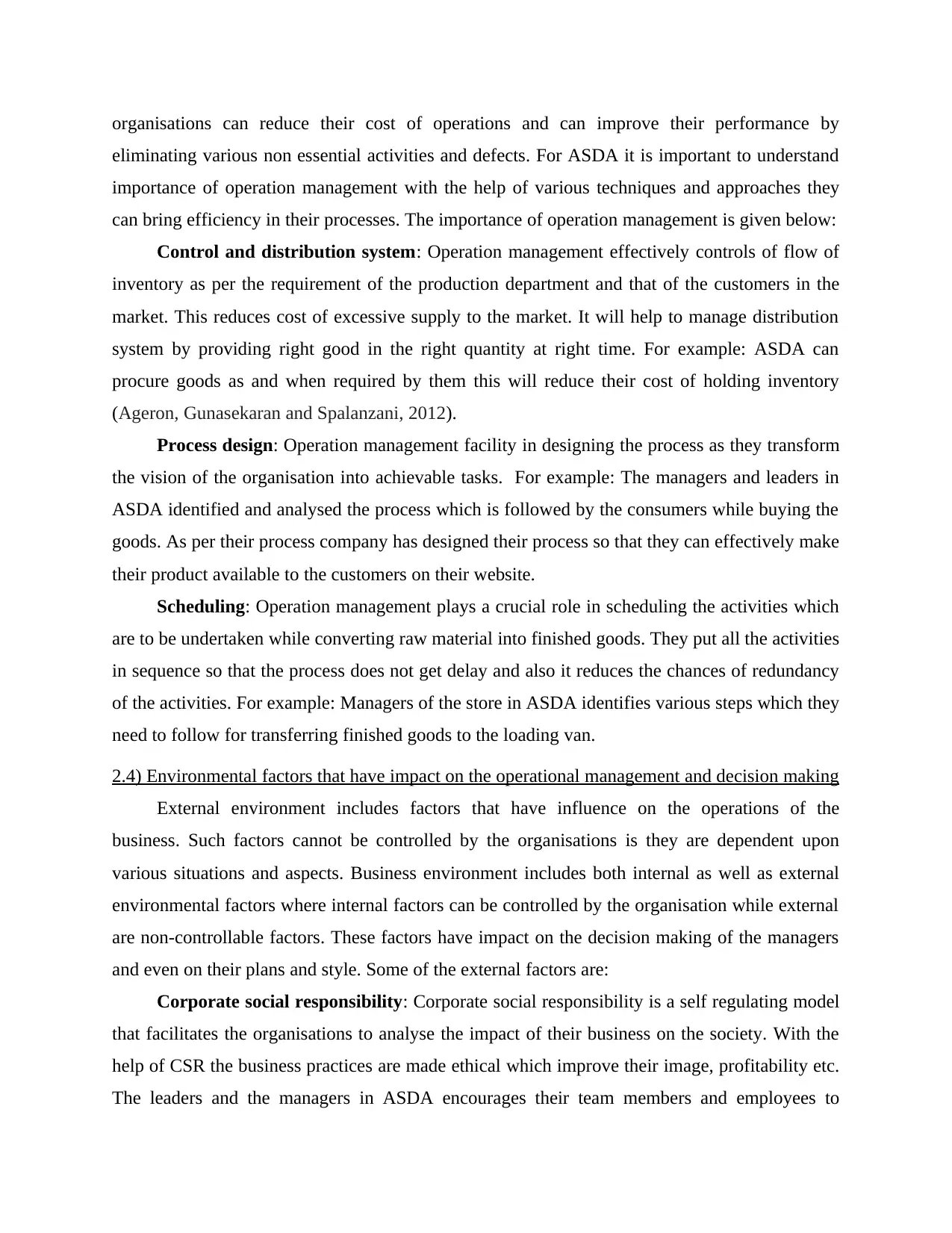
organisations can reduce their cost of operations and can improve their performance by
eliminating various non essential activities and defects. For ASDA it is important to understand
importance of operation management with the help of various techniques and approaches they
can bring efficiency in their processes. The importance of operation management is given below:
Control and distribution system: Operation management effectively controls of flow of
inventory as per the requirement of the production department and that of the customers in the
market. This reduces cost of excessive supply to the market. It will help to manage distribution
system by providing right good in the right quantity at right time. For example: ASDA can
procure goods as and when required by them this will reduce their cost of holding inventory
(Ageron, Gunasekaran and Spalanzani, 2012).
Process design: Operation management facility in designing the process as they transform
the vision of the organisation into achievable tasks. For example: The managers and leaders in
ASDA identified and analysed the process which is followed by the consumers while buying the
goods. As per their process company has designed their process so that they can effectively make
their product available to the customers on their website.
Scheduling: Operation management plays a crucial role in scheduling the activities which
are to be undertaken while converting raw material into finished goods. They put all the activities
in sequence so that the process does not get delay and also it reduces the chances of redundancy
of the activities. For example: Managers of the store in ASDA identifies various steps which they
need to follow for transferring finished goods to the loading van.
2.4) Environmental factors that have impact on the operational management and decision making
External environment includes factors that have influence on the operations of the
business. Such factors cannot be controlled by the organisations is they are dependent upon
various situations and aspects. Business environment includes both internal as well as external
environmental factors where internal factors can be controlled by the organisation while external
are non-controllable factors. These factors have impact on the decision making of the managers
and even on their plans and style. Some of the external factors are:
Corporate social responsibility: Corporate social responsibility is a self regulating model
that facilitates the organisations to analyse the impact of their business on the society. With the
help of CSR the business practices are made ethical which improve their image, profitability etc.
The leaders and the managers in ASDA encourages their team members and employees to
eliminating various non essential activities and defects. For ASDA it is important to understand
importance of operation management with the help of various techniques and approaches they
can bring efficiency in their processes. The importance of operation management is given below:
Control and distribution system: Operation management effectively controls of flow of
inventory as per the requirement of the production department and that of the customers in the
market. This reduces cost of excessive supply to the market. It will help to manage distribution
system by providing right good in the right quantity at right time. For example: ASDA can
procure goods as and when required by them this will reduce their cost of holding inventory
(Ageron, Gunasekaran and Spalanzani, 2012).
Process design: Operation management facility in designing the process as they transform
the vision of the organisation into achievable tasks. For example: The managers and leaders in
ASDA identified and analysed the process which is followed by the consumers while buying the
goods. As per their process company has designed their process so that they can effectively make
their product available to the customers on their website.
Scheduling: Operation management plays a crucial role in scheduling the activities which
are to be undertaken while converting raw material into finished goods. They put all the activities
in sequence so that the process does not get delay and also it reduces the chances of redundancy
of the activities. For example: Managers of the store in ASDA identifies various steps which they
need to follow for transferring finished goods to the loading van.
2.4) Environmental factors that have impact on the operational management and decision making
External environment includes factors that have influence on the operations of the
business. Such factors cannot be controlled by the organisations is they are dependent upon
various situations and aspects. Business environment includes both internal as well as external
environmental factors where internal factors can be controlled by the organisation while external
are non-controllable factors. These factors have impact on the decision making of the managers
and even on their plans and style. Some of the external factors are:
Corporate social responsibility: Corporate social responsibility is a self regulating model
that facilitates the organisations to analyse the impact of their business on the society. With the
help of CSR the business practices are made ethical which improve their image, profitability etc.
The leaders and the managers in ASDA encourages their team members and employees to
Paraphrase This Document
Need a fresh take? Get an instant paraphrase of this document with our AI Paraphraser
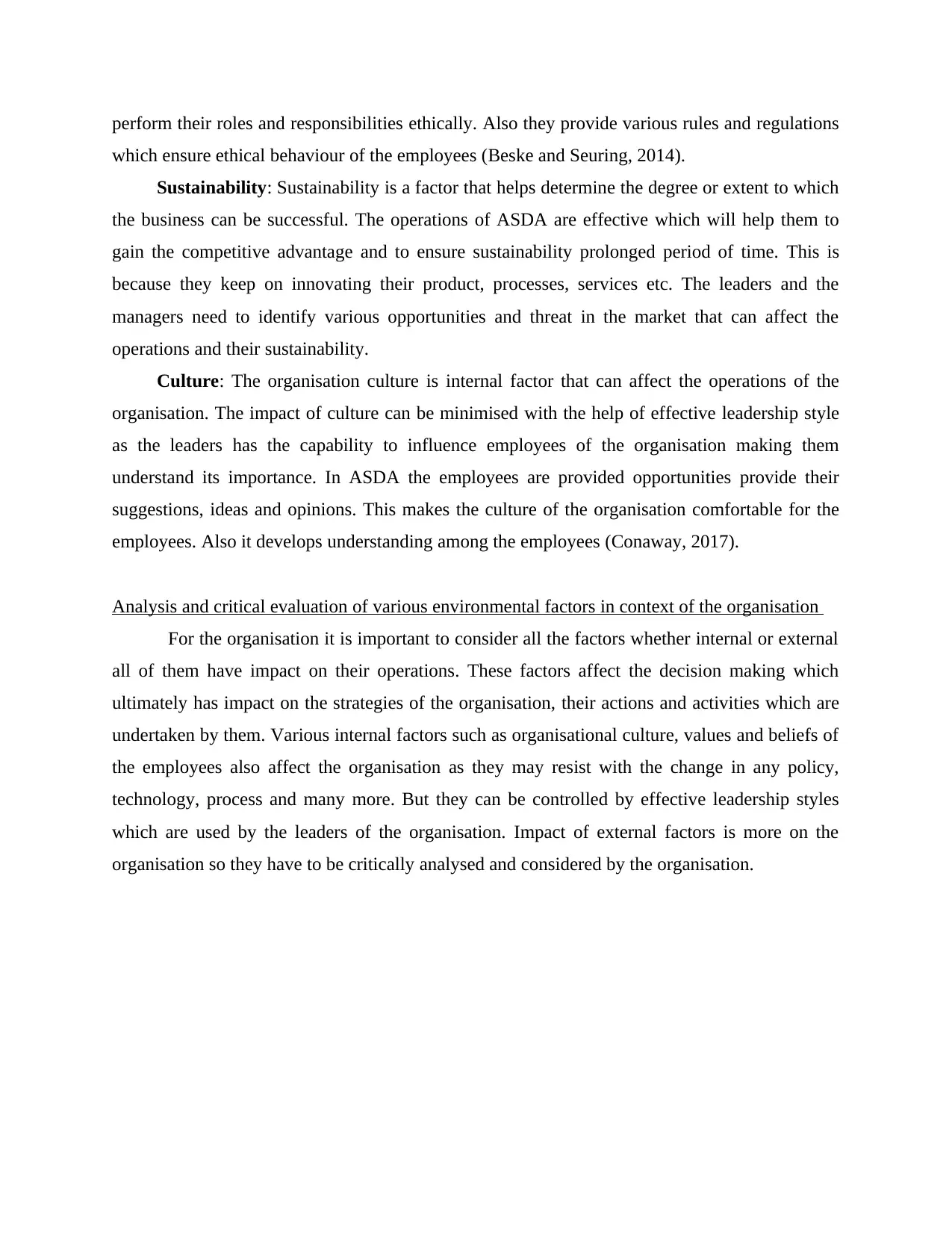
perform their roles and responsibilities ethically. Also they provide various rules and regulations
which ensure ethical behaviour of the employees (Beske and Seuring, 2014).
Sustainability: Sustainability is a factor that helps determine the degree or extent to which
the business can be successful. The operations of ASDA are effective which will help them to
gain the competitive advantage and to ensure sustainability prolonged period of time. This is
because they keep on innovating their product, processes, services etc. The leaders and the
managers need to identify various opportunities and threat in the market that can affect the
operations and their sustainability.
Culture: The organisation culture is internal factor that can affect the operations of the
organisation. The impact of culture can be minimised with the help of effective leadership style
as the leaders has the capability to influence employees of the organisation making them
understand its importance. In ASDA the employees are provided opportunities provide their
suggestions, ideas and opinions. This makes the culture of the organisation comfortable for the
employees. Also it develops understanding among the employees (Conaway, 2017).
Analysis and critical evaluation of various environmental factors in context of the organisation
For the organisation it is important to consider all the factors whether internal or external
all of them have impact on their operations. These factors affect the decision making which
ultimately has impact on the strategies of the organisation, their actions and activities which are
undertaken by them. Various internal factors such as organisational culture, values and beliefs of
the employees also affect the organisation as they may resist with the change in any policy,
technology, process and many more. But they can be controlled by effective leadership styles
which are used by the leaders of the organisation. Impact of external factors is more on the
organisation so they have to be critically analysed and considered by the organisation.
which ensure ethical behaviour of the employees (Beske and Seuring, 2014).
Sustainability: Sustainability is a factor that helps determine the degree or extent to which
the business can be successful. The operations of ASDA are effective which will help them to
gain the competitive advantage and to ensure sustainability prolonged period of time. This is
because they keep on innovating their product, processes, services etc. The leaders and the
managers need to identify various opportunities and threat in the market that can affect the
operations and their sustainability.
Culture: The organisation culture is internal factor that can affect the operations of the
organisation. The impact of culture can be minimised with the help of effective leadership style
as the leaders has the capability to influence employees of the organisation making them
understand its importance. In ASDA the employees are provided opportunities provide their
suggestions, ideas and opinions. This makes the culture of the organisation comfortable for the
employees. Also it develops understanding among the employees (Conaway, 2017).
Analysis and critical evaluation of various environmental factors in context of the organisation
For the organisation it is important to consider all the factors whether internal or external
all of them have impact on their operations. These factors affect the decision making which
ultimately has impact on the strategies of the organisation, their actions and activities which are
undertaken by them. Various internal factors such as organisational culture, values and beliefs of
the employees also affect the organisation as they may resist with the change in any policy,
technology, process and many more. But they can be controlled by effective leadership styles
which are used by the leaders of the organisation. Impact of external factors is more on the
organisation so they have to be critically analysed and considered by the organisation.
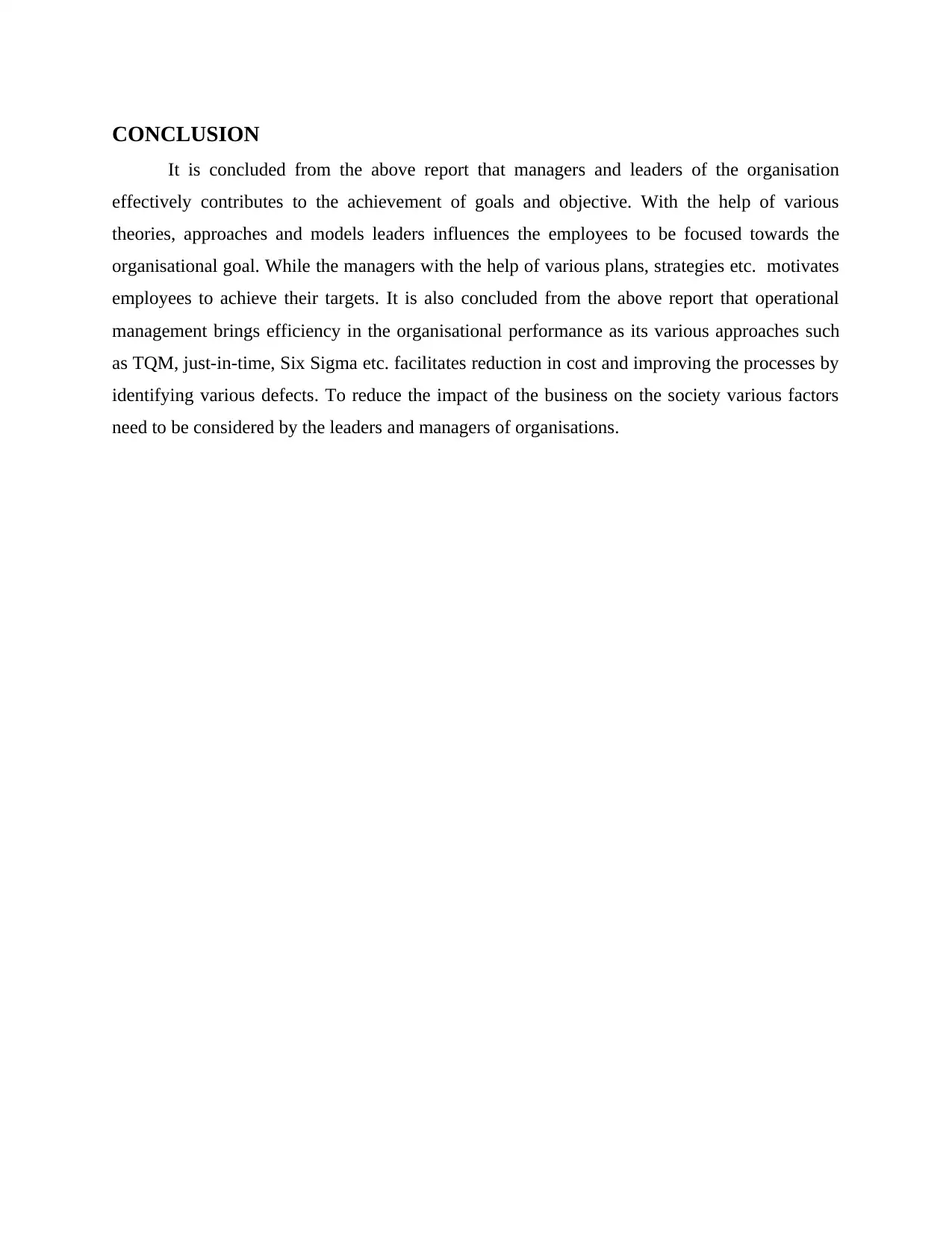
CONCLUSION
It is concluded from the above report that managers and leaders of the organisation
effectively contributes to the achievement of goals and objective. With the help of various
theories, approaches and models leaders influences the employees to be focused towards the
organisational goal. While the managers with the help of various plans, strategies etc. motivates
employees to achieve their targets. It is also concluded from the above report that operational
management brings efficiency in the organisational performance as its various approaches such
as TQM, just-in-time, Six Sigma etc. facilitates reduction in cost and improving the processes by
identifying various defects. To reduce the impact of the business on the society various factors
need to be considered by the leaders and managers of organisations.
It is concluded from the above report that managers and leaders of the organisation
effectively contributes to the achievement of goals and objective. With the help of various
theories, approaches and models leaders influences the employees to be focused towards the
organisational goal. While the managers with the help of various plans, strategies etc. motivates
employees to achieve their targets. It is also concluded from the above report that operational
management brings efficiency in the organisational performance as its various approaches such
as TQM, just-in-time, Six Sigma etc. facilitates reduction in cost and improving the processes by
identifying various defects. To reduce the impact of the business on the society various factors
need to be considered by the leaders and managers of organisations.
⊘ This is a preview!⊘
Do you want full access?
Subscribe today to unlock all pages.

Trusted by 1+ million students worldwide
1 out of 13
Related Documents
Your All-in-One AI-Powered Toolkit for Academic Success.
+13062052269
info@desklib.com
Available 24*7 on WhatsApp / Email
![[object Object]](/_next/static/media/star-bottom.7253800d.svg)
Unlock your academic potential
Copyright © 2020–2025 A2Z Services. All Rights Reserved. Developed and managed by ZUCOL.





